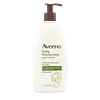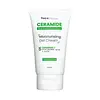What's inside
What's inside
 Key Ingredients
Key Ingredients

 Benefits
Benefits

 Concerns
Concerns

 Ingredients Side-by-side
Ingredients Side-by-side

Water
Skin ConditioningGlycerin
HumectantPropylene Glycol
HumectantCetearyl Alcohol
EmollientParaffinum Liquidum
EmollientStearic Acid
CleansingCeramide NP
Skin ConditioningAvena Sativa Kernel Extract
AbrasiveCeramide Ns
Skin ConditioningCeramide Ng
Skin ConditioningCeramide As
Skin ConditioningCeramide EOP
Skin ConditioningCeramide AP
Skin ConditioningSodium Hyaluronate
HumectantTocopherol
AntioxidantGlyceryl Stearate
EmollientPEG-100 Stearate
Triethanolamine
BufferingPhenoxyethanol
PreservativeAcrylates/C10-30 Alkyl Acrylate Crosspolymer
Emulsion StabilisingSodium Benzoate
MaskingCyclohexane
SolventDisodium EDTA
Hydrogenated Lecithin
EmulsifyingCastor Oil Hydrogenated Ethoxylated
PerfumingButylene Glycol
HumectantWater, Glycerin, Propylene Glycol, Cetearyl Alcohol, Paraffinum Liquidum, Stearic Acid, Ceramide NP, Avena Sativa Kernel Extract, Ceramide Ns, Ceramide Ng, Ceramide As, Ceramide EOP, Ceramide AP, Sodium Hyaluronate, Tocopherol, Glyceryl Stearate, PEG-100 Stearate, Triethanolamine, Phenoxyethanol, Acrylates/C10-30 Alkyl Acrylate Crosspolymer, Sodium Benzoate, Cyclohexane, Disodium EDTA, Hydrogenated Lecithin, Castor Oil Hydrogenated Ethoxylated, Butylene Glycol
 Reviews
Reviews

Ingredients Explained
These ingredients are found in both products.
Ingredients higher up in an ingredient list are typically present in a larger amount.
Glycerin is already naturally found in your skin. It helps moisturize and protect your skin.
A study from 2016 found glycerin to be more effective as a humectant than AHAs and hyaluronic acid.
As a humectant, it helps the skin stay hydrated by pulling moisture to your skin. The low molecular weight of glycerin allows it to pull moisture into the deeper layers of your skin.
Hydrated skin improves your skin barrier; Your skin barrier helps protect against irritants and bacteria.
Glycerin has also been found to have antimicrobial and antiviral properties. Due to these properties, glycerin is often used in wound and burn treatments.
In cosmetics, glycerin is usually derived from plants such as soybean or palm. However, it can also be sourced from animals, such as tallow or animal fat.
This ingredient is organic, colorless, odorless, and non-toxic.
Glycerin is the name for this ingredient in American English. British English uses Glycerol/Glycerine.
Learn more about GlycerinWater. It's the most common cosmetic ingredient of all. You'll usually see it at the top of ingredient lists, meaning that it makes up the largest part of the product.
So why is it so popular? Water most often acts as a solvent - this means that it helps dissolve other ingredients into the formulation.
You'll also recognize water as that liquid we all need to stay alive. If you see this, drink a glass of water. Stay hydrated!
Learn more about Water